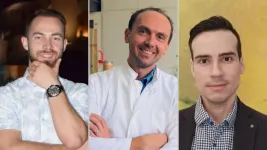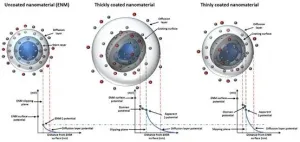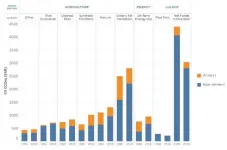(Press-News.org) Financing a sustainable global ocean economy may require a Paris Agreement type effort, according to a new report from an international team of researchers led by the University of British Columbia.
That's because a significant increase in sustainable ocean finance will be required to ensure a sustainable ocean economy that benefits society and businesses in both developing and developed countries.
The report, published today - on World Ocean Day - identifies major barriers to financing such a sustainable ocean economy. This includes all ocean-based industries, like seafood production, shipping and renewable energy, and ecosystem goods and services, such as climate regulation and coastal protection.
"The size of the ocean economy was estimated at around USD $1.5 trillion in 2010, and prior to the COVID-19 pandemic, was projected to increase to USD $3 trillion in 2030," said lead author Dr. Rashid Sumaila, a professor at UBC's Institute for the Oceans and Fisheries and the School of Public Policy and Global Affairs and Canada Research Chair in Interdisciplinary Ocean and Fisheries Economics.
"But a sustainable ocean economy requires healthy and resilient marine ecosystems, which are being severely threatened by anthropogenic and climate pressures," said Dr. Sumaila. "There are many opportunities for governments, financial institutions and other players to make financial gains in this type of sustainable economy -- but there are also many barriers that need to be overcome."
Four major barriers identified in the study include:
1. A weak enabling environment for attracting sustainable ocean finance;
2. Insufficient public and private investment in the ocean economy due to a lack of high quality, investible projects with appropriate deal size and risk-return ratios to match available capital;
3. A limited ability of people to visualize and develop projects that are attractive to investors; and
4. The higher relative risk profile of ocean investments, where the enabling environment for insurance and risk mitigation is also not in place.
Currently, there is a shortfall in financing a sustainable ocean economy. According to the researchers, governments and public institutions may be a good place to start, in order to close this gap.
"There is scope for raising money from the uses of the ocean, and for part of this to be used to improve its management," said Dr. Sumaila. "The gap in conservation financing for all ecosystems, which includes funds for a sustainable ocean economy, was estimated at USD $300 billion globally. That is less than one per cent of the global GDP. Can you imagine what we would have available if governments made two or three per cent available?"
This would lead to financial institutions being incentivised to invest, and to the development of an enabling environment with private sector actors who are interested in encouraging green ventures that foster ocean development.
"And then you get insurance companies involved, because working in the ocean is generally riskier than working on land," said Dr. Louise Teh, a research associate at the Institute for the Oceans and Fisheries.
The report's authors point to public-private partnerships that have had significant results, including special green investments funds offered by the Netherlands that are exempt from income tax, thus allowing investors in green projects - such as green shipping - to contract loans at reduced interest rates.
"These Dutch green funds have already attracted more investment than can be utilized in the available schemes - an encouraging sign for the future prospects of such instruments," said Dr. Sumaila.
The cost of inaction regarding the conservation and sustainable use of the ocean is high.
"If we carry on with 'business as usual' we still face the cost of coastal protection, relocation of people and loss of land to sea level rise - a cost that is projected to rise from USD $200 billion to a trillion USD annually by 2100," said Dr. Sumaila. "The centrality of adequate finance to ensure a sustainable ocean economy is such that the world may need a Paris Agreement type effort to meet the needs."
" END
Study identifies major barriers to financing a sustainable ocean economy
2021-06-08
ELSE PRESS RELEASES FROM THIS DATE:
Monarchs raised in captivity can orient themselves for migration, U of G study reveals
2021-06-08
Monarch butterflies raised indoors still know how to fly south if given enough time to orient themselves, according to new University of Guelph research.
The finding is good news for the many nature lovers and school students who raise monarchs and then set them free to help boost struggling numbers.
Monarchs are the only butterfly known to make a long-distance migration to warmer wintering grounds. While those born in the spring and early summer live only from two to six weeks, those that emerge in the late summer sense environmental signals that tell them to fly thousands of kilometres south, to central Mexico.
Recent ...
Machine learning reduces microscope data processing time from months to just seconds
2021-06-08
Ever since the world's first ever microscope was invented in 1590 by Hans and Zacharias Janssen --a Dutch father and son-- our curiosity for what goes on at the tiniest scales has led to development of increasingly powerful devices. Fast forward to 2021, we not only have optical microscopy methods that allow us to see tiny particles in higher resolution than ever before, we also have non-optical techniques, such as scanning force microscopes, with which researchers can construct detailed maps of a range of physical and chemical properties. IBEC's Nanoscale bioelectrical characterization group, led by UB Professor Gabriel Gomila, in collaboration with members of the IBEC's Nanoscopy for nanomedicine group, have been ...
AI could soon tell you, how often to see the eye doctor
2021-06-08
Age-related macular degeneration (AMD) is the most common cause of vision loss in people over 50. Up to 12 percent of those over 80 have the chronic disease. An estimated 16.4 million adults are affected by retinal vein occlusion (RVO) worldwide, a condition caused by a thrombosis of a retinal vein. It is the second most common cause of blindness from retinal vascular disease after diabetic retinopathy (DR). DR in turn is the leading cause of blindness in developed countries and affects up to 80 percent of people with more than 20 years of diabetes. It can lead ...
Scientists develop the 'evotype' to unlock power of evolution for better engineering biology
2021-06-08
A defining characteristic of all life is its ability to evolve. However, the fact that biologically engineered systems will evolve when used has, to date, mostly been ignored. This has resulted in biotechnologies with a limited functional shelf-life that fail to make use of the powerful evolutionary capabilities inherent to all biology.
Sim Castle, first author of the research, published in Nature Communications, and a PhD student in the School of Biological Sciences at Bristol, explained the motivation for the work: "The thing that has always fascinated me about biology is that it changes, it is chaotic, it adapts, it evolves. Bioengineers therefore do not just design static artefacts - they design living populations that ...
Mechanochemical peptide bond formation behind the origins of life
2021-06-08
The presence of amino acids on the prebiotic Earth is widely accepted, either coming from endogenous chemical processes or being delivered by extraterrestrial material. On the other hand, plausibly prebiotic pathways to peptides often rely on different aqueous approaches where condensation of amino acids is thermodynamically unfavorable. Now, chemists from the Ruđer Bošković Institute (RBI), in collaboration with colleagues from Xellia Pharmaceuticals, have shown that solid-state mechanochemical activation of glycine and alanine in combination with mineral surfaces leads to the formation of peptides. ...
Cosmic cartographers map nearby Universe revealing the diversity of star-forming galaxies
2021-06-08
A team of astronomers using the Atacama Large Millimeter/submillimeter Array (ALMA) has completed the first census of molecular clouds in the nearby Universe, revealing that contrary to previous scientific opinion, these stellar nurseries do not all look and act the same. In fact, they're as diverse as the people, homes, neighborhoods, and regions that make up our own world.
Stars are formed out of clouds of dust and gas called molecular clouds, or stellar nurseries. Each stellar nursery in the Universe can form thousands or even tens of thousands of new stars during its lifetime. Between 2013 and 2019, astronomers on the PHANGS-- Physics at High Angular Resolution in Nearby GalaxieS-- project conducted the first systematic survey of 100,000 stellar nurseries ...
An unprecedented survey of the 'nurseries' where stars are born
2021-06-08
COLUMBUS, Ohio - Astronomers have taken a big step forward in understanding the dark and violent places where stars are born.
Over the past five years, an international team of researchers has conducted the first systematic survey of "stellar nurseries" across our part of the universe, charting the more than 100,000 of these nurseries across more than 90 nearby galaxies and providing new insights into the origins of stars.
"Every star in the sky, including our own sun, was born in one of these stellar nurseries," said Adam Leroy, associate professor of astronomy at The Ohio State University and one of ...
Organic molecules reveal clues about dying stars and outskirts of Milky Way
2021-06-08
Researchers from the University of Arizona will present findings from radio-astronomical observations of organic molecules at the 238th Meeting of the American Astronomical Society, or AAS, during a press conference titled "Molecules in Strange Places" at the 238th AAS Meeting on Tuesday, June 8, at 12:15 p.m. EDT.
A team led by Lucy Ziurys at the University of Arizona reports observations of organic molecules in planetary nebulae in unprecedented detail and spatial resolution. Using the Atacama Large Millimeter Array, or ALMA, Ziurys and her team observed radio emissions from hydrogen cyanide (HCN), formyl ion (HCO+) and carbon monoxide (CO) in five planetary nebulae: M2-48, M1-7, M3-28, K3-45 and K3-58.
The ...
Online 'library of properties' helps to create safer nanomaterials
2021-06-08
Researchers have developed a 'library of properties' to help identify the environmental impact of nanomaterials faster and more cost effectively.
Whilst nanomaterials have benefited a wide range of industries and revolutionised everyday life, there are concerns over potential adverse effects - including toxic effects following accumulation in different organs and indirect effects from transport of co-pollutants.
The European Union H2020-funded NanoSolveIT project is developing a ground-breaking computer-based Integrated Approach to Testing and Assessment (IATA) for the environmental health and safety of nanomaterials.
Over ...
Food systems offer huge opportunities to cut emissions, study finds
2021-06-08
A new global analysis says that greenhouse-gas emissions from food systems have long been systematically underestimated--and points to major opportunities to cut them. The authors estimate that activities connected to food production and consumption produced the equivalent of 16 billion metric tons of carbon dioxide in 2018--one third of the human-produced total, and an 8 percent increase since 1990. A companion policy paper highlights the need to integrate research with efforts to reduce emissions. The papers, developed jointly by the UN Food and Agriculture Organization, NASA, New York University and experts at Columbia University, are part of a special issue of Environmental Research Letters on sustainable food systems.
The Center on Global Energy ...








